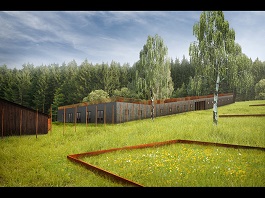
The Hodonín u Kunštátu Memorial is set to open in the summer
 |
The decision to build the memorial in the municipality of Blanensko in this form was made by the then Nečas government in 2011. The total costs are expected to be 98 million crowns. Once completed, the camp in Hodonín near Kunštát could become an exemplary workplace for educating teachers, students, and scholars about the history of the 20th century, the ministry stated. It mirrored Czechoslovak history.
During socialism, there was a recreational facility here. In December 2009, the Ministry of Education purchased the building from a private owner. In 2012, the premises were transferred to the management of the National Pedagogical Museum and Library of J.A. Comenius.
The exhibition will be divided into several parts. In the only preserved prison barrack, which has been renovated, there will be a so-called emotional part of the exhibition. People will be able to learn about the lives of prisoners in the so-called Romani camp, such as their food, hygiene, work regime, or the repressive measures they faced.
In the individual rooms of the renovated former guard barrack, equipment that changed according to the purpose served by the premises will be presented. In the newly built information center, there will be an exhibition explaining the events in the camp in the context of contemporary events in Czechoslovakia and Europe.
In the multifunctional hall, documentaries and feature films about World War II, the Holocaust, totalitarian systems of the 20th century, or human rights will be screened. There may also be thematic short-term exhibitions, lectures, debates, or educational events.
At the memorial site, there will be a pole for every person who died in this building. There were 288 of them, including 207 Roma. The largest space will therefore be dedicated to the remembrance of the so-called Romani camp.
Trial operation is expected to begin in July. In August, the ministry anticipates the start of full operation for the public. The costs for this year will be covered by the Ministry of Education from its budget. The government is expected to discuss the concept and method of financing the operation of the memorial from 2018 in the first half of the year.
The English translation is powered by AI tool. Switch to Czech to view the original text source.
0 comments
add comment
Related articles
0
08.12.2017 | The conversion of the memorial in Hodonín near Kunštát to a Roma museum has begun
0
18.09.2017 | The new memorial in Hodonín near Kunštát will be managed by the Romani museum
0
29.06.2017 | The Hodonín u Kunštátu Memorial will not open now, preparations have stopped
0
06.06.2017 | In Auschwitz, another museum is to be established
0
18.02.2017 | The Hodonín u Kunštátu Memorial could be under the Romani Culture Museum
0
29.07.2016 | A memorial to the Romani Holocaust is being created in Blanensko
0
19.08.2012 | The memorial to the Romani Holocaust will open in Blansko in 2016












